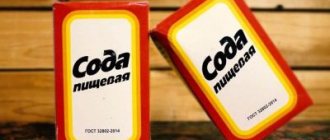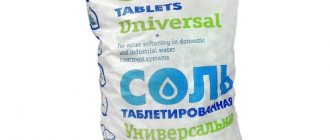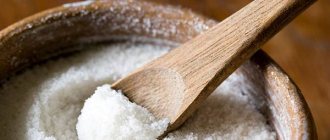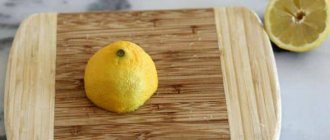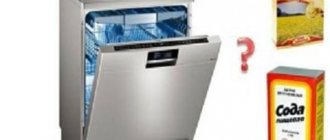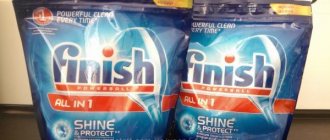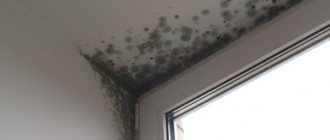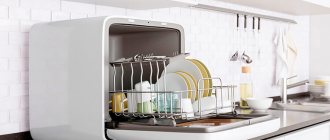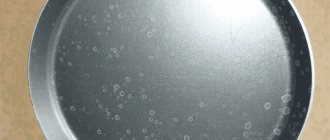What can replace special equipment?
All-purpose dishwasher detergents are not cheap. For example, a 1.3 liter bottle of Calgonit Finish gel costs 1,300 rubles. There are cheaper analogues - powdered and tablets. PMM owners who do not want to spend money on universal products can limit themselves to purchasing:
- Special salt;
- Rinse aids;
- Degreasers.
However, you still can’t do without general cleaning. Every month you need to carry out a “idle” wash with one of the effective detergents - special ones, substitutes like vinegar or citric acid, or compositions prepared independently.
Main types of chemicals for dishwashers
The most recommended detergents for use in dishwashers come in several common and commonly used categories, such as gel, tablets and powder.
dishwasher detergents
All of these detergents are well suited to any type of dishwasher and effectively cope with their tasks, washing all dishes to a perfect shine.
Let's look at each detergent in more detail:
- Gels. Gel-based detergents are absolutely safe for dishes and do not particularly affect human health, but they do not have a cheap price policy. They remove dirt efficiently without damaging the surface, since they do not contain hard particles and abrasives, so the gel dissolves perfectly when dropped into water. Well suited for washing porcelain and silverware;
- Pills. The pricing policy is more expensive than the other two detergents; they are more convenient to use than powder because they cannot crumble. They please with their high quality of cleaning dishes, one tablet is used for one cycle;
- Powders. Detergents of this type have the cheapest pricing, are convenient and effective to use. Unfortunately, they have negative sides: the powder, when placed in a special compartment of the dishwasher, can scatter by. Also, some chemical components have a hard structure and can scratch the surfaces of delicate dishes.
Is it possible to put baking soda in the dishwasher?
The answer is obvious: you can use it. The main thing is to know the technique of application so that the substance brings a positive result and is not wasted.
The basis of soda is sodium bicarbonate (Na2CO3). It is alkalis (which is what the substance is) that are part of washing powders and detergents. They break down stubborn stains, break down fats and are able to clean any kitchen utensils: from plates to baking sheets.
Important! Using baking soda or soda ash does not mean that there is no need for special equipment. Na2CO3 can become an additional assistant in washing, but is not a substitute for powder, gel, tablets, rinse aid or salt.
Experts do not recommend using soda in its pure form, despite the fact that it is present in every second detergent. This is due to the poor solubility of the component - if you try to dissolve a small amount of powder in a glass of water, you will see this for yourself.
The sediment does not immediately cause a breakdown; it gradually accumulates in the circulation pump, rendering it unusable. Therefore, replacing powder or gel with soda in its pure form will lead to the fact that breakdowns are unlikely to be avoided. And if you alternate homemade products with special ones and do not forget about regular cleaning of the PMM, then there will be no harm from such savings.
Baking soda + hydrogen peroxide
This is a long-known home remedy, for the production of which it is important to maintain proportions.
- Take 180 ml of boiling water and 1 tbsp. l. peroxide and sodium bicarbonate.
It is advisable to pour the mixture into a convenient container and shake.
The product is sprayed onto the contaminated area and left for 8±2 minutes, then washed off.
The disadvantage of this recipe is that for each use you will need to re-prepare the mixture, which quickly loses its cleaning properties during storage.
Instead of peroxide, you can use regular table vinegar.
How to make it yourself
To create a dishwashing detergent, you need to have minimal knowledge of chemistry and strictly follow the instructions. This will help avoid various troubles such as chemical burns and skin irritation.
Ingredients
To make dish soap, you will need different ingredients, depending on the recipe. You can find them at the pharmacy; some substances are worth looking for at home (soda, for example). Missing ingredients can be purchased at the hardware store.
Capacities
If you plan to create tablets, then take care of the molds; preference is given to ice molds. But, naturally, after using them for this purpose, further use for their intended purpose (as ice containers) will be impossible.
Can it be used in PMM?
What we used to call soda, a substance whose packaging design has not changed for years, is scientifically called sodium bicarbonate (NaHCO3). This white fine powder is alkaline in nature, and, as you know, alkalis are an integral component of powders, gels, tablets and capsules for dishwashers. Only thanks to alkalis are old dirt and fats broken down.
Before using a substance, it is worth studying the rules so that the product works and is not simply wasted. Thus, soda ash or baking soda cannot be an independent detergent or cleaning agent - it must be combined with other components.
On a note! Calcined powder, unlike food powder, has a more pronounced effect. But washing dishes should be as careful as possible and involve copious, high-quality rinsing to thoroughly remove any remaining substances from the surface.
Despite the fact that NaHCO3 is a component of household chemicals, dishwasher repair technicians do not recommend using soda for PMM in its pure form. This can easily be explained by the poor solubility of the substance.
Fact! Check for poor solubility of a substance by adding a pinch of NaHCO3 to a glass of water.
The suspension formed when NaHCO3 comes into contact with H2O does not immediately clog the drain pump - but it still inevitably leads to this with regular use. You should think twice before using soda instead of powder - after all, repairing equipment will cost much more than you will save. But if you alternately use homemade and store-bought products and do not neglect regular cleaning of the machine, everything will be fine, experts assure.
How much money does it cost per year?
Saving is one of the arguments for creating “folk recipes”. What amounts are we talking about? Costs depend on the type of special equipment:
- Tablet preparations - 6,000 rubles;
- Gel or powder product - 2000-3000 rubles. But when using them, you also need a rinse aid - plus 1000 rubles. Total 4000-5000 rubles.
A small family spends the same amount to pay for electricity for six months. There is a reason to think about saving.
Recipe No. 4 soap
The soap has excellent cleansing, whitening and foaming properties. To prepare a detergent with this component you will need:
- Grind the soap through a fine grater. Preferably children's or household items. For one application, 50-60 grams of shavings are enough.
- It must be dissolved in 1 liter of boiling water. You need to pour it in evenly, stirring constantly so that no lumps form.
- The liquid will resemble viscous jelly. You need to add 50 grams of soda to it.
- If desired, you can add 5-6 drops of essential oil. It will create a pleasant smell and add shine.
Next, you need to cool the gel. This effective composition will quickly deal with stains of any complexity. It can also be used for washing manually or automatically.
What are homemade dishwasher substitutes made of?
The key components are surfactants that easily break down fat. All other components are aimed at enhancing the splitting effect, extinguishing foam, aromatization, uniform dissolution and preservation. Special products may contain acids, bleach, sodium silicate, which resists corrosion, brighteners, enzymes, thickeners and much more.
Knowing the composition, you can independently prepare a mixture for washing dishes in PMM. For what? It is possible to adjust the percentage of components, achieving maximum harmlessness. Homemade preparations are prepared based on:
- Soap;
- Citric acid;
- Boers;
- Lye;
- Mustards.
Methods of use
Soda can become a full-fledged component of a powder or gel for washing or cleaning agent (from scale, plaque, stains). Usually the second option is common in everyday life. Let's look at popular homemade recipes.
Attention! The calcined analogue is more effective than the food grade one, so it requires careful handling and thorough rinsing from the dishes.
Water solution
By dissolving a few teaspoons of Na2CO3 in water, you can use the resulting liquid to clean the walls of the machine’s hopper, dish containers and filters.
Soda + vinegar
Cleaning with vinegar and soda will eliminate odors in the PMM bin. Proceed like this:
- Place a cup of vinegar on any basket and run the machine idle on a long mode.
- Add half a glass of baking soda and turn on the short program.
With peroxide and oil
Mix a glass of baking soda with 10 drops of any essential oil. Add 1.5 tablespoons of hydrogen peroxide to the resulting porridge. Mix thoroughly, place on a board or other surface and dry. Pour the resulting powder into the PMM, and place 0.5 cups of vinegar in the top container. Start the wash - at the end of the program there will be no stains left.
How to make powder
Take washing powder that does not contain phosphates and fragrances - the children's option is perfect for these purposes. Mix with soda and use 25 grams per cycle.
Recipe with calcined analogue
Mix regular laundry detergent with a small amount of soda ash. If you are afraid to use such a “thermonuclear” mixture for washing dishes instead of powder, you can soak pans or baking sheets in it - then it will be easier to clean or wash them.
Important! Soda mixtures require particularly thorough rinsing of dishes, so use a special rinse aid.
How to make tablets with your own hands
One of the popular remedies among PMM owners is capsules or, more simply, tablets. They don't cost as much as a pack of aspirin, so to save money, make them yourself using baking soda as a base.
Take these ingredients:
- 250 grams of magnesia (ask for sodium sulfate at the pharmacy);
- 100 grams of borax;
- 75 grams of soda;
- juice from half a lemon or a tablespoon of citric acid dissolved in water.
Mix the dry ingredients, then add lemon juice - you will see the “pop” familiar from childhood. When the reaction stops, pour the mixture into molds (ice trays will do). Dry the tablets and they are completely ready for use. What distinguishes them from “3 in 1” capsules is the absence of a rinse aid. Therefore, do not neglect its separate use for maximum washing quality.
On a note! By dissolving the tablet in water, you will receive a liquid product that can also be used to successfully wash any dishes.
How to wash dishes in the dishwasher - homemade substitutes
If you don’t have chemicals at hand or you fundamentally don’t want to use them, turn to natural products. You can wash the dishwasher:
- Mustard. There is a lot of controversy regarding it. It is believed that mustard powder clogs the holes in the rocker arm. Opponents are confident that mustard is an excellent cleaner that allows you to reduce the frequency of disassembling and cleaning the device. Both opinions are correct. The point is the difference in the design and degree of grinding of the mustard seeds. If they are hand-ground, you may end up with too large fractions. If the grinding is good, then mustard will be the best natural remedy for cleaning dirty surfaces. It is cheap and environmentally friendly. Before loading the dishes into the compartment, they are slightly moistened and then covered with mustard.
- Baking soda. Removes grease, burnt marks and heavy dirt well. It is poured into the compartment, having first been mixed with borax in a 1:1 ratio.
- Laundry soap. A mixture is prepared from grated shavings - 25 g mixed with 0.5 liters of hot water, 4 tbsp. l. glycerin and 1 tbsp. l. alcohol/vodka. Absolutely harmless to health.
- Apple vinegar. It is not as aggressive as normal. Does not destroy rubber and aluminum parts. 50-60 ml of vinegar is poured into the compartment for bulk compounds.
You can also use ash, salt, crushed charcoal - they are especially good at cleaning glassware until it shines.
Mustard and soda: reviews
Mustard is a famous detergent used by our grandmothers, so a reasonable question arises: will mustard and soda cope with the dishes if you pour such a mixture into the dishwasher? We decided to give examples of several reviews from thematic forums so that you can decide for yourself whether it is worth using it or not.
Tatiana, Ufa
Complete nonsense! I ran out of powder, read enough tips and poured soda and mustard powder into the bin. A divorce in every sense. I don't recommend it to anyone.
Olga, Chelyabinsk
Why waste a car? Dissolve mustard in a bowl of water, soak the dishes, then rinse with a sponge and soda - and everything will shine. If you rinse well. It’s not a fact that the machine will accept such a homemade product, and it will be 5 times faster with your hands.
Alina, Nizhny Novgorod
I liked it: I mixed a couple of spoons of powder with a spoon of mustard and two spoons of soda. I left it to dissolve for half an hour. I poured it in and washed the dishes. But it’s boring and the smell is not as pleasant as from the pills, I won’t bother anymore
Detailed instructions for cleaning the dishwasher:
Listed below are all the stages of cleaning the machine, and you can either use any of the products we described or act without their help, the main thing is to follow the sequence of actions:
- Wash the filter mesh, which is located on the back of the machine on the fill valve. To get to it, you need to twist the intake hose (by hand). It is best to remove the filter with pliers.
- Clean the filter located in the PMM hopper.
- Clean the blades.
- Get to grips with the seals.
- ABOUT.
Important! The dead zone is the area located at the bottom of the door. Due to the fact that practically no water flows to this place, dirt accumulates there and cleaning is required here.
- Destroy grease, mold, rust.
- Get rid of limescale (scale).
- Wipe down your equipment.
Can I use washing powder?
Before the advent of effective special products for washing large and difficult-to-clean dishes, housewives used to use washing powder - it easily cleaned off any dirt. However, it absolutely cannot be used in PMM because:
- Creates a lot of foam - it interferes with high-quality washing;
- Contains toxic substances that remain on the surface of the plates even after repeated rinsing. If you wash dishes with powder and then heat food in it in a microwave oven, you can get poisoned or have an allergic reaction.
Do-it-yourself detergent compositions
Homemade recipe
It was invented by thrifty housewives. The annual cost is 700 rubles. To prepare you need to stock up:
- Soda - calcined Na2CO3 / food grade NaHCO3;
- Dry mustard;
- Inexpensive washing powder.
The ratio of soda, mustard and powder is 10:3:3. After pouring everything into a metal or glass container, store the composition in a cool, dry place. Shelf life: six months. Advantages:
- Cheapness;
- Easy to make - the ingredients are readily available and mixing them is not difficult.
The disadvantage is the presence of surfactants. We have already talked above about the dangers of this remedy. True, there won't be much of it here. The second disadvantage is that mustard can clog the impeller. The option is tolerable, it washes dishes well, but you need rinse aid so that there are no streaks left on the plates. It is advisable to alternate the “homemade product” with special tablets for PMM. If you use the homemade composition constantly, you will have to clean the device weekly.
Rinse aid substitute
Replacing rinse aid is much easier than replacing special detergents. A budget substitute is prepared from 100 ml of water, 50 ml of hand washing gel and 30 ml of ethyl alcohol. All this is carefully mixed, but not shaken. This must be done every time before use. Housewives claim that this composition is an excellent replacement for gel for washing not very dirty dishes.
Homemade tablets
It is impossible to make a complete substitute for tablets that combine several effects. But it is not difficult to produce an ersatz product of classic tablet drugs. You will need:
- Epsom salt - 100 g;
- Borax (can be bought at your nearest pharmacy) - 100 g;
- Freshly squeezed lemon juice - 100 g;
- Soda ash - 200 g.
Preparation procedure:
- Pour the ingredients into the container and gradually add lemon juice. The composition, which must be constantly stirred, will emit a hissing sound.
- When the mixture “goes silent”, it is poured into an ice tray.
- The mold is placed in direct sunlight or, in the worst case, on a hot radiator.
- When the cubes are dry, they are taken out - these are the finished tablets.
Such cubes easily replace cheap analogues produced specifically for dishwashers.
With hydrogen peroxide
You will need soda ash, hydrogen peroxide and hot water. For a glass - a teaspoon of both. This solution will not cope with burnt pans, but it will work well for forks, spoons, and plates.
With mustard
Ingredients: 250 g mustard, 125 g borax, 250 g soda ash. Store in the dark. This composition is good for both dishwasher and hand washing.
Homemade "chemistry"
This recipe is distinguished by the presence of chemical components. It is prepared not for the sake of environmental friendliness and safety, but to save money. This is an offer from amateur home chemists. In fact, this is also an ersatz product, a cheap analogue of store-bought chemicals. You will need:
- Neonol - 25 g;
- Sulfanol - 25 g;
- Soda (baking/ash) - 950 g.
The first two components are surfactants, they are commercially available. It turns out that a 30-gram dose contains only 1.5 g of surfactant. It is inconvenient to pour such a tiny amount into the compartment, so a powdery substance is used for the base. A kilogram of this home remedy costs only 50 rubles. It performs well in water with low hardness. For tough ones, be sure to add salt.
Recipes from users
№1
Consumers never stop sharing new recipes. There are especially many people who want to create effective substitutes for tablets. The latter are the most effective. You will need:
- Washing powder - 700 g;
- Soda - 300 g.
They are diluted with a small amount of water and poured into a mold, for example, for ice cubes. It is important here that the volume of the product does not exceed the dimensions of the dispenser.
№2
Required components:
- Children's powder - 80 g;
- Soda - 20 g;
- A little regular hand washing liquid.
Pour the mixture into molds. Suitable for Eco mode.
№3
Ingredients:
- Baking soda - 150 g;
- Borax - 200 g;
- Magnesia - 1500 g.
The components are mixed and adjusted to the desired consistency by adding citric acid/lemon juice. This composition is more environmentally friendly than the previous two.
When preparing tablets, it is advisable to wear gloves and even a mask - the components are too dusty.
№4
Homemade gel:
- Boil a liter of water;
- Add 50 g of laundry soap;
- Stir until smooth;
- Add 45 g of soda ash. Stir until it dissolves;
- Wait until the composition cools down;
- Add a few drops of essential oil;
- The product can now be used. It is poured into a container from which it will be taken as needed.
№5
Homemade rinse:
- Lemon juice - 5 tbsp;
- Essential oil - 2 tbsp;
- Glass cleaner - 1 tbsp.
Ways to use soda
You can use dishwasher soda either as an ingredient in homemade dishwashing powder or as a dishwasher cleaner. The second option is the most popular. Here are a few recipes for using baking soda.
- You can wipe and wash the walls of the dishwasher chamber with a soda solution, as well as wash filters and dish baskets.
- Vinegar combined with baking soda will help get rid of the unpleasant odor that appears inside the car. To do this, first run the dishwasher on a long cycle without dishes, after placing a cup of vinegar on one of the baskets. And after that, they start a short cycle by pouring half a glass of baking soda, but not soda ash, into the machine.
- For the next recipe you need to take one glass of soda, add 10 drops of any essential oil and 1.5 tbsp. spoons of hydrogen peroxide. After mixing all the ingredients, you need to dry the mixture and then pour it into the machine. Place half a glass of vinegar in the upper basket, and then turn on the washing program. Such cleaning of the car will not leave a trace of plaque.
- To wash kitchen utensils and dishes, you can make your own dishwashing powder. For the base, we use children's washing powder, which does not contain phosphates or fragrances. The powder is mixed with soda and used as a regular dishwasher detergent, at the rate of 25 g per wash.
- Another recipe involves using soda ash. A small amount of soda ash is mixed with washing powder - the product is ready. If you don’t want to wash dishes with this powder in the dishwasher, then at least it is very suitable for soaking pots and pans, as it copes with complex stains.
Important! When using powders based on baking soda and soda ash, you need to rinse the dishes thoroughly, and also use rinse aid and dishwasher salt.
Making pills
Among all dishwasher detergents, tablets are in great demand. In order not to overpay for store-bought tablets, you can make them yourself. They are convenient to use, and they are not expensive, since one of their components is baking soda, which is quite cheap and accessible.
To prepare these homemade tablets, you will need:
- 250 g of magnesia (also known as magnesium sulfate);
- 100 g borax;
- 75 g regular baking soda;
- diluted citric acid or squeezed lemon juice.
The dry ingredients are thoroughly mixed, and then lemon juice is added to them. When the reaction between soda and juice, accompanied by hissing, is completed, you can pour the wet mixture into small molds. Then you need to dry the molds, and the tablets are ready. They must be used together with special dishwasher salt and rinse aid, then the effect will be maximum.
For your information! If you dissolve the tablet in a small amount of water, you get a liquid product that can also be used to wash dishes.
What dishwasher manufacturers say
The instructions for dishwashers spell out the basic rules on how and what to wash dishes with. Most manufacturers recommend using commercial salt, powder and rinse aid. And some emphasize that special salt cannot be replaced with regular salt. The same applies to detergents.
In addition, do not forget that if the machine breaks down as a result of violation of operating rules, the warranty becomes invalid. Therefore, if you decide to wash dishes with soda or other improvised means, then be prepared for repairs at your own expense.
You can also wash dishes with combined tablets or capsules; they are easy to use. However, before you buy such tablets, find out whether your machine recognizes 3 in 1 products. After all, if it does not do this, then there is no point in such tablets; the maximum effect may not be obtained.
In conclusion, we note that you can wash dishes with soda, but it is not recommended to do this in the dishwasher all the time. As a last resort, you can alternate soda-based products with special products. In our opinion, baking soda is better for cleaning the dishwasher and eliminating odors, as well as soaking dishes with burnt food. Maybe user reviews will help you, but you shouldn’t trust them one hundred percent. Good luck!
Interesting:
- How to descale your dishwasher
- What can replace dishwasher tablets?
- Homemade dish detergent
- Cleaning the washing machine with folk remedies
- Using soda for a washing machine
- Detergents for children's dishes
Reader comments
- Share your opinion - leave a comment
Video
Another recipe for making briquettes for washing tableware with your own hands:
About the author:
Egor Taranenko Electronics engineer with many years of experience. For several years I was engaged in organizing the repair of household appliances. I am glad to share with readers my knowledge in the field of operation and repair of devices. Loves sport fishing, water tourism and travel.
Found a mistake? Select the text with the mouse and click:
Did you know that: Fresh lemon is not only good for tea: clean dirt from the surface of an acrylic bath by rubbing with half a cut citrus, or quickly wash the microwave by placing a container of water and lemon slices in it for 8-10 minutes at maximum power. The softened dirt can simply be wiped off with a sponge.
The dishwasher cleans more than just plates and cups. You can load it with plastic toys, glass lamp shades and even dirty vegetables, such as potatoes, but only without using detergents.
If your favorite things show the first signs of gestation in the form of untidy pellets, you can get rid of them using a special machine - a shaver. It quickly and effectively shaves off clumps of fabric fibers and returns things to their proper appearance.
Before removing various stains from clothing, you need to find out how safe the selected solvent is for the fabric itself. It is applied in a small amount to an inconspicuous area of the item from the inside out for 5-10 minutes. If the material retains its structure and color, you can move on to stains.
There are special traps to combat moths. The sticky layer with which they are covered contains female pheromones that attract males. By sticking to the trap, they are eliminated from the reproduction process, which leads to a decrease in the moth population.
The habit of using an automatic washing machine “sparingly” can lead to the appearance of an unpleasant odor in it. Washing at temperatures below 60℃ and short rinses allow fungi and bacteria from dirty clothes to remain on internal surfaces and actively multiply.
Threads made of gold and silver, which were used to embroider clothes in the old days, are called gimp. To obtain them, the metal wire was pulled for a long time with pliers to the required fineness. This is where the expression “to drag out the rigmarole” came from - “to do long, monotonous work” or “to delay the completion of a task.”
The easiest way to remove scale and carbon deposits from the soleplate of the iron is with table salt. Pour a thick layer of salt onto the paper, heat the iron to maximum and run the iron over the salt bed several times, applying light pressure.
Stretch ceilings made of PVC film can withstand from 70 to 120 liters of water per 1 m2 of their area (depending on the size of the ceiling, the degree of its tension and the quality of the film). So you don’t have to worry about leaks from neighbors above.
Brain powder or how to make dishwasher powder 9.7 times cheaper
Update
A new version of the powder and a more detailed analysis in the second part: DIY powder for the dishwasher: we analyze industrial products and improve the recipe
Now I’ll tell you how to make dishwasher powder from baking soda and washing powder. Same composition, only much cheaper.
There are many areas of our life where our perception is formed exclusively by marketing bullshit. Unfortunately, most people don’t even try to think about what lies at the heart of it all. Very often, the market situation leads to the fact that the cost of a product is 0.5% of its price. The rest is marketing, markups, logistics, packaging and the like. Almost everyone is aware of the concept of selling printer ink at the price of the tears of Himalayan virgins and the insistent recommendations of manufacturers to use only original consumables. For example, quite recently it dawned on me that 1.5 grams of dry matter in a bottle of plant fertilizers cannot cost 200-250 rubles. But this is exactly the amount that can fit in a relatively stable state in the form of a solution. I immediately imagined hectares of fields and trucks carrying tons of powder
. As a result, I switched to packaging 1 kg of Buiskiye complex dry fertilizers. You can prepare a bath of solution.
Today we will create an ultra-cheap dishwasher powder. The decrease in real wages and the rise in price of imported household chemicals forced us to rummage through textbooks, look through a bunch of materials from chemist forums and try to find ways to save on consumables. The cost of the powder has become very noticeable. The results of thoughtful research and experiments were very surprising. For industrial use, chemical technologists most often create individual formulations depending on the water quality and tasks. Why don't we try to figure it all out?
TLDR:
70% baking soda and 30% washing powder instead of detergent. If you are too lazy to bother with soda, then just Biolan powder or its analogues. Soda makes it cheaper. Table salt "Extra" instead of salt.
Types of pollution
What do we need from the powder? Weird question. To wash. Well, it is desirable that it is not highly toxic and does not dissolve dishes along with the dishwasher. The detergent must cope with the main types of contaminants:
- Fat. The main pollutant is all kinds of frying oils, salad dressings, fingerprints, as well as fatty sauces, etc.
- Protein contamination. Less common, but difficult to remove, are eggs, cereals and other similar options.
- Dyes. Tea, coffee, beets and other highly colored things.
- Smell. A chicken that has been left in a container for a couple of weeks can give you quite a thrill.
- Inert mechanical pollutants. Sawdust, stuck pieces of greenery, radioactive dust and all sorts of little things.
- Unknown burnt crap from the party before last. Nothing will help. Don't get your hopes up. Throw away dishes.
Various surfactants (surfactants) cope well with the first type of pollution. These are chemical compounds that, concentrating at the interface between thermodynamic phases, cause a decrease in surface tension. In a simplified way, you can imagine this as enveloping fat particles with surfactant molecules and preventing them from sticking back to the surface.
This class of substances is quite extensive and includes two main groups: ionic (anionic) and nonionic surfactants. The former disintegrate into ions in solution (salts of fatty acids, for example, ordinary liquid soap is potassium salts), the latter do not dissociate (alkyl glycosides and others). Anionic ones, as a rule, clean better, but are more aggressive.
Protein stains are a little more complicated. Traditionally, dishwasher powder includes enzymes that hydrolyze protein into small peptide pieces. Enzymes are capricious, they work in a small range of pH and temperature, since they themselves are proteins. At high washing temperatures (over 60 degrees), almost all of them will be denatured and stop working. An alternative option, more typical for industrial products, is the creation of an alkaline environment. Many people used a pipe cleaner like “Mole” and the like. Contains detergents (surfactants) and alkali (sodium hydroxide). This whole hellish mixture destroys almost any organic matter, including proteins and fats. Proteins are broken down into individual peptides and amino acids. Fats turn into soap: The same reaction underlies one of the ancient methods of producing soap from vegetable and animal fats. The main disadvantage is that it creates a very aggressive environment. Concentrated alkali will just as happily dissolve the skin on your hands. Caution is required in use.
With dyes everything is quite simple. As a rule, to bleach a pigment, it is enough to oxidize it, changing its structure. Most often this is achieved with active oxygen or chlorine. Suffice it to recall hydrogen peroxide and various versions of bleach, which easily discolor tea, coffee, pomegranate juice, and the like. Be sure to be included in both powders for dishwashers and washing machines. For fabric, softer options are used so as not to dissolve the factory pattern on the clothes. The odor is eliminated by these same oxidizing agents, since the “smelling” molecules also react with these components.
Mechanical pollution does not require the use of household chemicals at all. High jet pressure and hot water are sufficient for washing dishes.
Washing powder in the dishwasher
The idea may seem a little strange to you, but automatic washing powder is almost identical to dishwasher powder. In order not to be unfounded, let's look at the typical composition and purpose of each component. For the detailed description I would like to thank avor
from the forum www.chemport.ru. Analysis of the components of two typical representatives, one “eco-friendly”, the second “children’s”.
"Ecover": zeolites, sodium disilicate, C12-18 sodium alkisulfate, sodium carbonate, sodium bicarbonate, sodium sulfate, ethoxylated methyl esters of rapeseed oil fatty acids, sodium polyaspartate, sodium cocoate, cellulose gum, methylcellulose, magnesium sulfate.
“Aistenok”: 5%-15% natural fat-based soap, oxygen bleach, phosphates (in terms of P2O5), less than 5% nonionic surfactants, sodium silicate, polycarboxylates, optical brightener, foam regulator, phosphonates, aromatic additives.
- Zeolites are solid insoluble substances that absorb some contaminants (they can leave fine dust if rinsed poorly) and are inert to the body; they are used in medicine as enterosorbents.
- sodium disilicate (liquid glass) - a thickener, adhesive, granulating agent is obtained on the basis of sand and caustic soda, dangerous only at high pH.
- sodium silicate is the same as sodium disilicate.
- sodium carbonate, sodium bicarbonate - this is soda ash and baking soda used to regulate pH and soften water - toxic only at high pH.
- Sodium C12-18 alkyl sulfate is a synthetic surfactant based on fatty alcohol (the source can be either vegetable or petroleum) and sulfuric acid. Used in shampoos, low or no toxicity.
- ethoxylated methyl esters of fatty acids of rapeseed oil - synthetic nonionic surfactants based on ethylene oxide and methyl esters of rapeseed oil fatty acids, semi-natural product, toxicity see alkyl sulfates.
- Sodium polyaspartate is an expensive additive based on a natural amino acid, serves as a thickener, water softener, and contaminant desorber, and is non-toxic and absorbed by the body like food.
- Sodium cocoate is an analogue of ordinary soap, but not based on animal fatty acids, but on the basis of coconut oil fatty acids.
- Cellulose gum is a derivative of cellulose (wood). The purpose is the same as sodium polyaspartate, low toxicity.
- methylcellulose - similar, but used as a thickener.
- magnesium sulfate. - used in medicine, both for intravenous and oral administration - magnesia. Powders contain an inert filler.
- natural fat-based soaps - regular soap, but with fatty acids of animal origin, similar to sodium cocoate
- oxygen bleach - sodium perborate or percarbonate is similar in properties to peroxide, which girls use to bleach their hair; during washing they decompose and kill microflora; the decomposition products are low toxic (borates) or practically non-toxic (carbonates).
- phosphates (in terms of P2O5) - water softener and pH regulator sodium tripolyphosphate, phosphates are used as food additives and have low toxicity.
- less than 5% nonionic surfactants - compounds similar to ethoxylated esters of rapeseed oil fatty acids, however, products derived from petroleum can also be used as a hydrophobic component (similar to alkyl sulfates)
- polycarboxylates - either carboxymethylcellulose or derivatives of polyacrylic acid (used in diapers, in particular in cosmetic gels) toxicity is low, the purpose is the same as polyaspartates and cellulose gum (the latter may generally be identical)
- optical brightener - a blue-type dye makes white linen shine with white light due to fluorescence, the toxicity is average, but the doses in the powder are 10,000 - 100,000 times less than what is needed to feel a simple malaise from the effect of this dye on the body.
- foam regulator, defoamer - usually silicone-based oil (analogs are used for breast prosthetics) if it is not in the composition, then the powder cannot be used in drum washing machines, the toxicity is extremely low.
- phosphonates - water softeners, low toxicity
- fragrance additives - usually less toxic than women's perfume.
Actually, all of the listed components are non-toxic and have passed all imaginable tests, including tests for washability, teratogenic and oncogenic effects on experimental rats. If you don’t eat it with spoons, there won’t be any health problems. If poorly washed and toxic substances were used in the production of washing powders for clothes, then consumers would already have contact dermatitis from wearing such things. I liked the wording from the same forum, describing the “technological complexity” of producing such powders:
Well, to make a good car, you need a whole science and expensive equipment. We need an army of qualified specialists. And to use household chemicals of this kind, you need a barrel, an oar, market scales, and two guest workers. And a boss who can read, write and count to one hundred.
Now let's compare it with the composition of dishwasher powders. Let's take a completely standard Finish powder.
I was somewhat confused by the beginning “15% or more, but not less than 30%”, which is logically correct, but looks extremely strange. I read it incorrectly) The main components are a surfactant for fats, an oxidizing agent (bleach for stains), polyphosphate - a softener, enzymes - the destruction of proteins. Here is a similar composition of the very common Somat powder:
Non-ionic surfactants, phosphates, phosphonates, soda, silicate, polymers, oxygen-based bleaching agents, TAED, enzymes, corrosion inhibitor, dyes, fragrance, water.
Now let's take washing powder. I tried options with “Eared Nanny” and Biolan.
The same with minor variations. Biolan's composition is absolutely similar:
Phosphates (15% or more but less than 30%), anionic surfactants (5% or more but less than 15%), nonionic surfactants (less than 5%), enzymes, flavoring.
As you can see, there is nothing criminal in the composition. The substances used vary only slightly among different manufacturers. The only “extra” components for a dishwasher are optical brightener. But this fluorescent is present in microdoses and is perfectly washed off during rinsing. In the same “Biolan Automatic” it is not available at all. Of course, there will always be abnormal chemophobes, but let's leave them the right to wash everything with soap nuts and mustard powder. If there are strange individuals who are willing to pay for it, then why not charge them a multiple markup for an “Eco-organic” product? By the way, “Eared Nanny” is pleasant with its faint odor, but is essentially identical in composition to our other powders - Lotus, Max, Regular powder, Sarma. The only difference is in flavors and marketing positioning.
Let's play alchemist
By choosing a minimally smelling and foaming powder for automatic washing machines, you could calm down. The price savings are already very significant. But we will not stop there and will try to radically reduce the cost of the final dishwashing detergent. I immediately apologize for the quality of some of the photos - I took them with my slippers, but I have a normal camera at work right now.
As the base of the product, we will take the well-known and very cheap baking soda. Baking soda itself is sodium bicarbonate - NaHCO3
.
In solution it has a slightly alkaline reaction and has cleaning properties. But it is much more effective to use the product of its thermal decomposition - washing soda, also known as sodium carbonate - Na2CO3
. Sodium carbonate already has a sharply alkaline reaction in solution, about 11 pH. It reacts with fats to form soap, and successfully hydrolyzes proteins. It is very easy to obtain sodium carbonate - just heat it above 60 degrees.
I recommend using a saucepan/pan and heating in the oven for an hour.
As a result, the resulting powder loses about 25% in weight. Be careful when working with sodium carbonate!
The substance can cause burns to mucous membranes, eyes and other body surfaces. Use gloves, do not eat, do not inhale and be careful. Soda is not a terrible poison, but alkaline burns have never brought joy to anyone. Now it remains to combine 70% sodium carbonate and 30% washing powder in order to add a small amount of detergents, bleach and other components. By the way, as a result of dilution, we reduce the total amount of potentially unwashed surfactants.
Preliminary tests
The first thing washing soda has to deal with is grease. The test sample was a frying pan after frying a pork chop.
After the standard cycle, the picture is more than acceptable. The frying pan felt clean to the touch, I didn’t notice any grease contamination.
A particularly difficult test. Protein and fat contamination. Burnt oatmeal with milk. Such contaminants are rarely removed the first time, even by “special” powders. We try it in enhanced mode, without cleaning anything first.
The result is good. There were small traces of this disgrace left, but I don’t think other powders would have washed off better.
We count the savings
It’s a little difficult for me to calculate the exact figure, but let’s try to at least roughly compare. The price of a conventional pack of soda weighing 500 g is 20 rubles. Price per 100 g - 4 rubles. You can find it much cheaper if you buy the bag in bulk, but this is too much. Now the powder. I would advise choosing powders with minimal odor. “Eared nanny” is quite suitable for automatic machines. The price for a 4.5 kilogram package in the first store you come across is 439 rubles. The price for 100 g is approximately 10 rubles. In total, a kilogram of our product will cost 7*4+3*10= 58 rubles.
Now “special” Finish powder is 560 rubles per kg. The difference is about 10 times!
If you take tablets that contain the same thing, only with beautiful granules, then the difference will be completely prohibitive.
Let's try to estimate the scale of savings for the year. Approximately 20 g of powder is consumed per wash. In my family of 4, the dishwasher usually runs twice a day, but let's take 1 run per day as an average. 20*365 = 7300 g of powder per year. This is 4088 rubles for the “special” and 423 rubles for our version.
Special salt
Another classic way to make money is using a special salt for regenerating an ion exchange filter. Of course, you can’t pour rock salt and sand there. But let’s raise GOST R 51574-2000 for “Extra” grade table salt. Mass fraction of NaCl - no less than 99.7%. The rest is minor impurities of calcium and magnesium. Sorry, but according to the classification of the purity of chemical reagents, this is better than “Pure for analysis” - “analytical grade.” This is “Chemically pure” (“reagent grade”) - the highest degree of purity of the reagent. The content of the main component is more than 99%. The only caveat is that you don’t need to take iodized or fluoridated varieties. Do you believe that salt, which is standardized by GOST for purity, is suitable for consumption, but is not clean enough for the dishwasher?
Potential Cons and Problems
Just to be clear, I am not responsible for the performance of your dishwasher or any potential health problems associated with eating, drinking, or otherwise misusing the results of the experiments.
I am only describing my experience and information received in this area. If there are professional chemists among you, I will be glad to listen to your point of view. The only problem I can potentially see is that due to the high alkaline reaction of the solution, particularly delicate painted porcelain, wine glasses or something similar can be damaged. But such things can generally be washed without using detergents. I still recommend that you carefully test everything and weigh it. From the point of view of health problems, I don’t see anything seditious. We use surfactants even in lower concentrations than in special powders. The basis is harmless sodium carbonate, which is part of antacid preparations for the treatment of gastritis. Allergic reactions to components of washing powder? If you wash your clothes with it and everything is fine, then no problems are expected. When washing by hand, you leave many times more residual dishwashing detergent on your plates and cups. And nothing critical happens. In any case, I would like you to consciously understand what exactly you are doing in terms of household chemicals and why.
useful links
It seems to me that the opinion of professional chemical technologists is much more significant than traditional hysterical squirrels on forums dedicated to getting rid of terrible chemistry and a complete transition to “eco”, “bio”, “organic” products made from “natural” ingredients. I hope the links provided will enable many people to reconsider their views and stop suffering from chemophobia.
- Dishwasher detergent
- Using washing powder in the dishwasher
- Chemical composition of safe household chemicals.
- Fantastic washing powder Umvay??
UPD
Guzzle and apakin users offer a cheap option from a local Russian manufacturer.
Sold in Auchan, called Sanit. Approximate price 100 rubles/kg. It is 2 times more expensive than the considered option, but it is designed directly for dishwashers. Photos of the pack
UPD2
The powder turned out to be not very good. Cleans decently, but worse than soda and washing powder. Leaves marks on dishes and is not completely washed off the surface during rinsing. Standard mode. It will probably be possible to dilute it with baking soda until the flush is clear.
UPD3 Genegineer also advised me to pay attention to the large packaging of salt in washers for large regeneration systems. Packaging 25 kg, price around 600 rubles, i.e. around 25 rubles per kilo. Here, for example, is an option from Leroy:
Advantages and disadvantages
The main advantages of homemade gels and tablets are low cost and safety. The user at least knows what he uses to wash plates and cups. The disadvantage is that it takes time. It is much easier to buy everything you need in a store. The appearance of homemade products is also not particularly attractive, and they do not last long. And you need to calculate the dosage yourself.
Where to insert
The drug is placed in the main compartment for detergent, unless a special compartment is provided. The container is closed and has a hole for water supply. Some manufacturers advise placing the tablet directly on the bottom of the machine. This is permissible to do only if the instructions contain a corresponding recommendation. In most cases, 1 tablet is enough for 1 cycle of work. If the load is incomplete, the drug can be divided into 2 parts and inserted into the compartment separately.
Is it possible to put liquid detergent in the dishwasher?
There is no point in putting it down according to the norm, since in this case most of the active chemicals are washed down the drain. It has been experimentally proven that liquid product should be poured into the dishwasher cuvette 1/3 less than the amount stated in the instructions.
Interesting materials:
What can be made from old walnuts? What can be made from garlic arrows? What can you make from pancake batter? What can be made from pumpkin pulp? What can you do with a Cappuccino Maker? What can mom do for the New Year? What can be done with a 3D printer? What can you do on Teacher's Day? What can you do with a home 3D printer? What can you do for a year of relationship?


